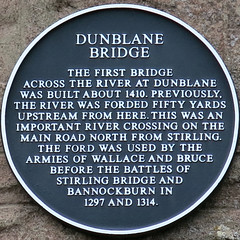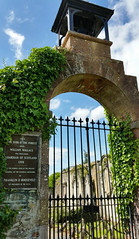Sir William Wallace


Sir William Wallace
(1270-1305)
Scottish patriot, hero of Scotland, struck the first blow for Scottish independence (1288), and Knight Bachelor (from 1297)
Commemorated on 8 plaques
To the immortal memory of Sir William Wallace Scottish Patriot born at Elderslie Renfrewshire circa 1270 AD. who from the year 1296 fought dauntlessly in defence of his country's liberty and independence in the face of fearful odds and great hardship being eventually betrayed and captured brought to London and put to death near this spot on the 23rd August 1305. His example heroism and devotion inspired those who came after him to win victory from defeat and his memory remains for all time a source of pride, honour and inspiration to his countrymen. Dico Tibi Verum Libertas Optima Rerum Numquam Servili Sub Nuxu Vivito Fili Bas Agus Buaidh
Smithfield, London, United Kingdom where they was put to death near
This memorial erected 1900 AD by public subscription is to mark the site of the house in which the hero of Scotland was basely betrayed and captured about midnight on 5th August 1305 when alone with his faithful friend and co-patriot Kerlie who was slain. Wallace's heroic patriotism as conspicuous in his death as in his life roused and inspired his country that within nine years of his betrayal the work of his life was crowned with victory and Scotland's independence regained on the field of Bannock Burn
Robroyston Road, Robroyston, Glasgow, United Kingdom where they captured
Site of the Battle of Stirling Bridge. In early September 1297 a mighty army arrived in Stirling to put down Scots resistance to English rule. The Scots allowed around half of the invaders to advance across the narrow bridge over the Forth. Then William Wallace and the Scots swept forward to achieve a brilliant victory over a far-superior force.
Stirling Bridge, Causewayhead Road, Stirling, United Kingdom where they won a battle (1296)
Site of Castle of Dundee destroyed cir 1314 - near this spot William Wallace struck the first blow for Scottish independence cir 1288. Here was the birthplace of Admiral Duncan 1731 victor of Camperdown 1797. In house adjoining the Chevalier De St. George spent the night of 6th January 1716 after public entry into Dundee
High Street, Dundee, United Kingdom where they struck the first blow for Scottish independence near this spot (1287)
Dunblane Bridge The first bridge across the river at Dunblane was built about 1410. Previously, the river was forded fifty yards upstream from here. This was an important river crossing on the main road north from Stirling. The ford was used by the armies of Wallace and Bruce before the Battles of Stirling Bridge and Bannockburn in 1297 and 1314.
Millrow, Dunblane, United Kingdom where they was
Site of The Kirk O' The Forest where William Wallace was proclaimed Guardian of Scotland 1298. In the Murray aisle of the present building, lie the maternal ancestors of Franklin D Roosevelt 32nd President of the U.S.A.
Kirk O'The Forest, Kirk Wynd, TD7 5LR, Selkirk, United Kingdom where they was (1298)
Near this spot, at the Kings Bench at the South end of the Hall, took place the trial of Sir William Wallace the Scottish Patriot on Monday, 23rd August 1305
Westminster Hall, Parliament, London, United Kingdom where they was
Wallace's Well. Near this spot William Wallace is thought to have taken refuge and sustenance whilst fleeing from his enemies (scouts of the King of England) following a visit to St Margaret's shrine in 1303. The site is also pictured and recorded by Mr Patrick Geddes in his 1904 study of Dunfermline and has changed very little since then.
Pittencrieff Park, Dunfermline, United Kingdom where they hid








